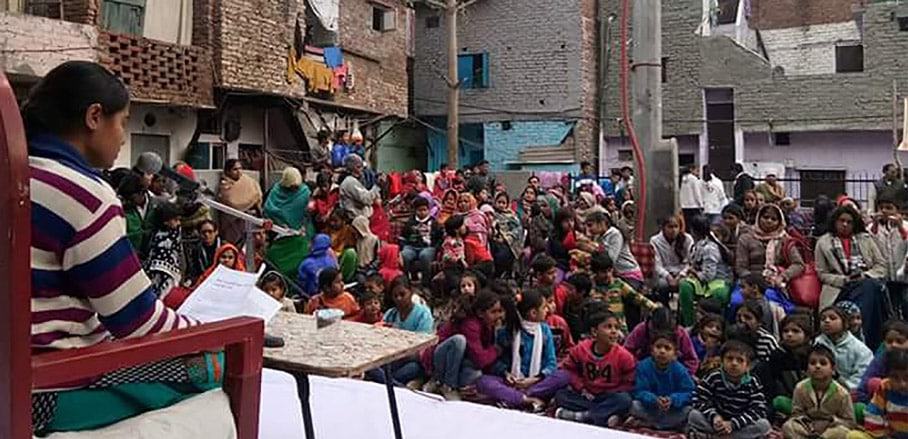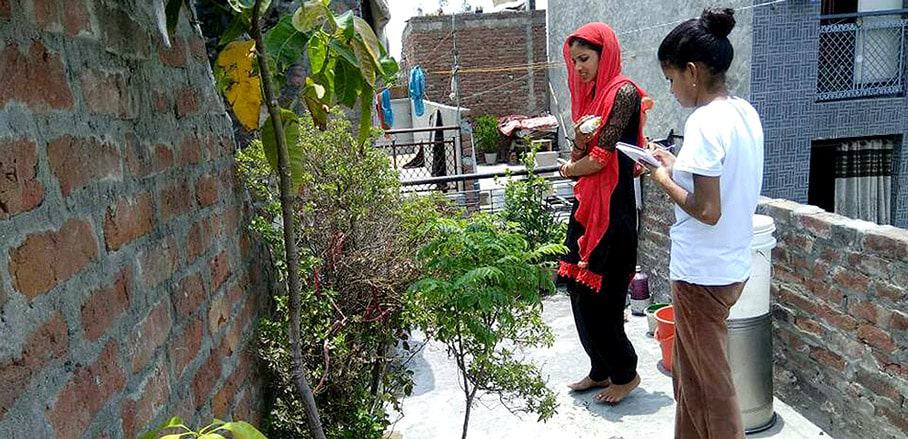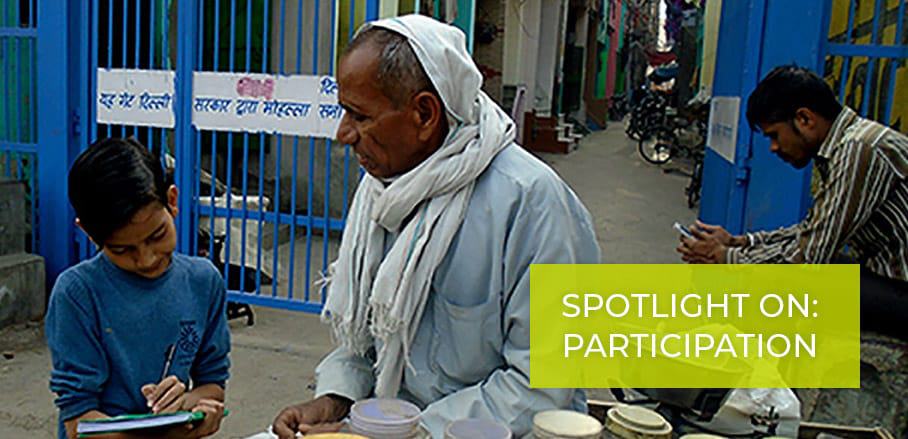Rewriting the Narrative
By Sharmila Bhagat
Children gather numerous stories in their everyday surroundings – Ankur Society for Alternatives in Education, based in New Delhi, India, helps them turn these stories into empowering experiences, making them a voice for their communities.
The Neighbourhood as a Learning Resource
Indian cities are continually expanding, in the name of development and in a hurry to project the country’s flourishing economy. The working class – indispensable to the economy’s growth—continues to remain on the periphery of official thinking. It is seen as a burden: the educated elite views the urban poor as uncultured, uneducated, unskilled, unhygienic, and as a threat to law and order. This deficit discourse is reflected in various institutions, including the schools that view the students from marginalised neighbourhoods as good for nothing and as incapable of achieving anything in life. This perception is internalised by the children and makes them unconfident.
Ankur aims to counter this discourse through empowering pedagogical practices for children and young people from marginalised neighbourhoods in Delhi. The settlements are spread across the city – LNJP is in Central Delhi, Khichripur and Sundernagari in the East and Savda Ghevra in North West. They are inhabited by migrants, mostly from the northern states Uttar Pradesh, Uttarakhand, Rajasthan and Bihar. The average income of the family is 8,000 to 10,000 rupees (4 to 5 dollars) a day.
Children gather numerous stories and experiences from their surroundings. However, they rarely find the space to share and reflect on these experiences in school or elsewhere. Ankur believes that children need nurturing spaces for learning that keep alive their innate curiosity; spaces that invite them to share their stories, perspectives, and imaginations and to collectively create knowledge. Ankur collectives encourage children to engage in sustained practices of listening, speaking, writing, reading and research. These practices draw upon the neighbourhood as a learning resource and enhance the children’s confidence to express, articulate, reflect and converse with people. The outcomes of their explorations are then turned into posters, wall magazines, booklets, films, audios and books. Their community is the first place where their creative works are circulated.

© Ankur Society for Alternatives in Education
Sharing of Stories, Skills, and Passions
The neighbourhood is a rich repository of stories about human endeavour. For example, tales of families finding a foothold in the city after migrating from their village, making their homes, dealing with lack of basic services, building new friendships, supporting each other, handling crises, maintaining ties in their native village, finding livelihoods, dealing with government institutions. Listening to these stories from adults, children learn about the resourcefulness and the grit of people, about the paths of families, and about changes in the neighbourhood and the city over time.
The settlements are teeming with multiple livelihood skills. Conversations with workers expose children to the immense diversity of the working world around them: there are tailors, mechanics, drivers, cobblers, masons, carpenters, junk dealers, vendors, etc. The majority of them are self-employed. From them, children learn about their daily routine, their work networks, the process of acquiring these skills, trades’ specialist vocabulary, negotiations with clients and other key actors, about the challenges they face and about their aspirations.
There are individuals in the community who are passionate about reading, writing, music, dance, theatre, drawing, poetry, photography, films, drawing, painting, craft work, sports etc. They steal time from their busy routines to pursue these interests, either on their own or with a few others, However, these pursuits are often not encouraged by their families, for they see them as a waste of time, effort, and opportunities. Therefor it is rare for individuals to share their passions with the community. Interactions with these individuals help children discover resources they can learn from.
Responding to Their Community`s Challenges
The neighbourhoods grapple with a host of challenges, such as lack of basic services, threat of or actual demolition, gender discrimination, joblessness and child labour, tensions and conflicts, youth delinquency and substance abuse, sickness and illness. Together with their families, children cope with these situations. Children of Ankur collectives interact with people to understand their experiences, perspectives, and the ways in which they address these challenges. This helps them build a deeper understanding of issues around them and appreciate the catalysts and initiatives for change. Here is an account in their own words of how their communities are engaging with air pollution.

© Ankur Society for Alternatives in Education
Rewriting the Narrative
As children discover the knowledge, skills, creativity and resourcefulness of their communities, they become more rooted in their contexts and more confident in navigating their lives. The neighbourhood begins to acknowledge children as creative beings, to take pride in them, and to support them in their endeavours. [inlinetweet prefix=”” tweeter=”” suffix=””]They are seen as storytellers, writers, reporters, editors, artists, photographers and as responsible individuals of the community[/inlinetweet]. Gently, a dent is made in the power hierarchies based on age, gender, and social categories. There is increased communication and trust in relationships within the families and the community. School start seeing the potential of children and responds to their creative works. [inlinetweet prefix=”” tweeter=”” suffix=””]Children are rewriting the narratives of their communities as an act of empowerment and have become a voice for themselves and their communities.[/inlinetweet] Entering these narratives into the public discourse on participation in cities makes this discourse more inclusive – and thus provokes a rethinking of urban margins. It underlines that they, too, are citizens of the city, who play a vital role in it and who have immense potential.
- Rewriting the Narrative - 29. May 2018
